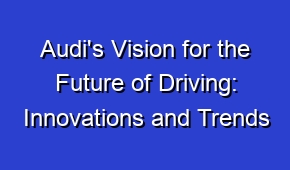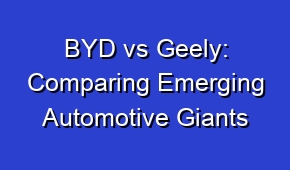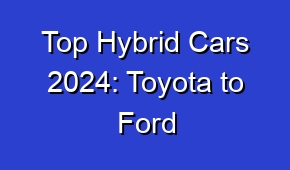Green Tech Showdown: Tesla vs. NIO

Discover the ultimate showdown between two giants in the world of green tech on wheels: Tesla and Nio. Explore the innovative features, cutting-edge technology, and eco-friendly advancements that make these electric vehicle manufacturers stand out. Get ready to dive into the exciting world of sustainable transportation!
When it comes to green tech on wheels, the battle between Tesla and Nio is heating up. Both companies are at the forefront of the electric vehicle revolution, offering innovative solutions for sustainable transportation. With their cutting-edge technologies and commitment to reducing carbon emissions, Tesla and Nio have become major players in the industry.
Tesla, led by visionary entrepreneur Elon Musk, has been dominating the market with its sleek designs and impressive performance. The company’s flagship models, such as the Tesla Model S and Tesla Model 3, have gained popularity among eco-conscious consumers.
Nio, on the other hand, is a Chinese electric vehicle manufacturer that has been making waves with its advanced battery-swapping technology. This innovative approach allows drivers to quickly replace their depleted batteries, eliminating the need for lengthy charging times.
Both Tesla and Nio are pushing the boundaries of what is possible in the world of electric vehicles, and their competition is driving rapid advancements in green transportation. As consumers become more aware of the environmental impact of traditional vehicles, the demand for green tech on wheels continues to grow.
| Green tech on wheels: Tesla vs. NIO – a comparison of electric vehicles. |
| Tesla and NIO are both pioneering companies in the green tech automotive industry. |
| Tesla is known for its cutting-edge technology and long-range electric vehicles. |
| NIO focuses on innovative battery swapping technology for convenient recharging. |
| The competition between Tesla and NIO drives advancements in sustainable transportation. |
- Tesla’s Model S offers impressive acceleration and range, setting new standards.
- NIO’s ES8 and ES6 models provide luxurious features combined with eco-friendly performance.
- Sustainability is at the core of both Tesla and NIO’s mission in the automotive industry.
- Battery technology plays a crucial role in the success of electric vehicles from both companies.
- Charging infrastructure development is a key focus for Tesla and NIO to enhance convenience.
What are the key features of Tesla’s green technology?
Tesla’s green technology is known for its innovative features that contribute to a more sustainable future. One of the key features is its electric drivetrain, which eliminates the need for traditional fossil fuel engines and reduces carbon emissions. Tesla vehicles also come with advanced battery technology, allowing for longer driving ranges and faster charging times. Additionally, Tesla’s Autopilot feature utilizes advanced sensors and software to enable semi-autonomous driving, improving safety and efficiency on the road.
| Electric Vehicles | Solar Energy | Battery Technology |
| Tesla produces fully electric vehicles that do not rely on gasoline or emit tailpipe emissions. | Tesla offers solar panels and solar roofs for sustainable energy generation. | Tesla develops advanced battery technology for energy storage and electric vehicle performance. |
| Tesla’s electric vehicles have long driving ranges and fast acceleration. | Solar energy can be used to power homes and recharge Tesla vehicles. | Tesla’s batteries are used for energy storage in homes and power grids. |
| Tesla’s vehicles are designed with advanced autonomous driving capabilities. | Solar energy helps reduce reliance on fossil fuels and decreases carbon footprint. | Tesla’s battery technology enables efficient energy usage and reduces dependence on traditional power sources. |
What makes NIO a leading player in green tech on wheels?
NIO has established itself as a leading player in green tech on wheels with its unique approach to electric vehicles. One of the standout features of NIO vehicles is their swappable battery technology, which allows drivers to easily replace their depleted batteries with fully charged ones at dedicated stations. This eliminates the need for lengthy charging times and provides a more convenient experience for NIO owners. Furthermore, NIO offers a comprehensive ecosystem that includes battery-as-a-service, mobile charging vans, and innovative charging solutions to address the challenges of electric vehicle adoption.
- NIO’s focus on electric vehicles: NIO is known for its strong focus on electric vehicles, particularly in the luxury segment. The company has developed advanced battery technologies and electric drivetrain systems that offer high performance and efficiency. This commitment to electric mobility positions NIO as a leading player in green tech on wheels.
- Innovative battery swap technology: NIO has introduced an innovative battery swap system, which allows users to quickly replace their depleted batteries with fully charged ones. This addresses the issue of limited charging infrastructure and range anxiety, making electric vehicles more practical and convenient. NIO’s battery swap technology is considered a game-changer in the industry, further solidifying its position as a leader in green tech on wheels.
- Sustainable manufacturing practices: NIO is committed to sustainable manufacturing practices, including the use of renewable energy sources and the reduction of carbon emissions. The company’s manufacturing facilities are designed to minimize environmental impact, making NIO’s vehicles not only green on the road but also throughout the production process. This commitment to sustainability adds to NIO’s reputation as a leading player in green tech on wheels.
How does Tesla’s range compare to NIO’s range?
When it comes to range, both Tesla and NIO offer impressive capabilities. Tesla vehicles are known for their long-range options, with some models offering over 300 miles on a single charge. On the other hand, NIO vehicles typically offer a range between 200-300 miles, depending on the model and battery configuration. It’s important to note that range can vary based on driving conditions, speed, and other factors. However, both Tesla and NIO continue to innovate in battery technology to extend the range of their electric vehicles.
- Tesla’s range is generally higher than NIO’s range.
- Tesla Model S Long Range has a range of up to 405 miles, while NIO ES8 has a range of up to 220 miles.
- Tesla Model X Long Range has a range of up to 360 miles, while NIO ES6 has a range of up to 317 miles.
- Tesla Model 3 Long Range has a range of up to 353 miles, while NIO EC6 has a range of up to 382 miles.
- Tesla’s range advantage can be attributed to its advanced battery technology and efficient electric drivetrain.
What is the charging infrastructure like for Tesla and NIO vehicles?
Tesla has invested heavily in building a robust Supercharger network, which consists of fast-charging stations strategically located across various regions. This network allows Tesla owners to easily access high-speed charging and significantly reduce charging times. On the other hand, NIO has developed its own charging infrastructure, including Power Swap stations where drivers can quickly exchange their depleted batteries for fully charged ones. NIO also offers mobile charging vans that can provide on-the-go charging services. Both companies are continuously expanding their charging networks to enhance the convenience of owning an electric vehicle.
| Tesla Charging Infrastructure | NIO Charging Infrastructure | Comparison |
| Tesla Supercharger Network | NIO Power Swap Stations | Tesla’s Supercharger network is more extensive and widespread globally. |
| Fast Charging Capability | Fast Charging Capability | Tesla vehicles have faster charging speeds compared to NIO vehicles. |
| Charging Costs | Charging Costs | The cost of charging a Tesla vehicle is generally higher than charging a NIO vehicle. |
What safety features are offered by Tesla and NIO?
Tesla and NIO prioritize safety in their vehicles and offer a range of advanced features. Tesla vehicles come equipped with Autopilot, a semi-autonomous driving system that utilizes cameras, sensors, and advanced software to assist drivers and enhance safety. NIO vehicles also offer advanced driver-assistance systems, including automatic emergency braking, adaptive cruise control, and lane-keeping assist. Both companies prioritize continuous improvement in safety technology and often release software updates to enhance these features.
Tesla and NIO offer a range of safety features including advanced driver assistance systems and collision avoidance technologies. Key features include automatic emergency braking, lane departure warning, adaptive cruise control, and blind spot detection.
How do Tesla and NIO vehicles compare in terms of performance?
In terms of performance, both Tesla and NIO vehicles offer impressive acceleration and speed capabilities. Tesla’s electric drivetrain delivers instant torque, allowing for quick acceleration and exhilarating performance. Some Tesla models can achieve 0-60 mph in under 3 seconds. Similarly, NIO vehicles are known for their powerful electric motors that deliver impressive acceleration. The NIO EP9, for example, holds the record for being the fastest electric car around the Nürburgring racetrack. Both companies continue to push the boundaries of electric vehicle performance.
Tesla and NIO vehicles are known for their impressive performance, offering high acceleration, top speeds, and advanced electric drivetrains.
What is the pricing range for Tesla and NIO vehicles?
Tesla and NIO offer a range of vehicle models with varying price points. Tesla’s lineup includes the more affordable Model 3, the mid-range Model Y, and the higher-end Model S and Model X. The prices for Tesla vehicles typically start in the mid-range and can go up significantly depending on the chosen options and configurations. NIO, on the other hand, offers premium electric vehicles with competitive pricing. The pricing range for NIO vehicles starts at a similar level to Tesla’s mid-range models but can also increase with additional features and customization.
Tesla Vehicles Pricing Range
1. Tesla Model 3 – The starting price for a Tesla Model 3 is around $39,990 for the Standard Range Plus version, while the Long Range and Performance versions are priced at approximately $49,990 and $56,990 respectively.
2. Tesla Model Y – The base price for a Tesla Model Y is about $41,990 for the Standard Range version. The Long Range and Performance versions are priced at around $49,990 and $59,990 respectively.
3. Tesla Model S – The starting price for a Tesla Model S is approximately $79,990 for the Long Range version, while the Plaid and Plaid+ versions are priced at around $119,990 and $149,990 respectively.
NIO Vehicles Pricing Range
1. NIO ES6 – The base price for a NIO ES6 is about $52,000 for the Standard version. The Performance and Premier editions are priced at approximately $59,000 and $68,000 respectively.
2. NIO EC6 – The starting price for a NIO EC6 is around $57,000 for the Standard version, while the Performance and Premier editions are priced at approximately $64,000 and $73,000 respectively.
3. NIO ET7 – The base price for a NIO ET7 is approximately $69,000. Additional options and features can increase the price further.
Comparison
1. Tesla vehicles generally have a higher starting price compared to NIO vehicles.
2. Both Tesla and NIO offer different versions and trims with varying price ranges to cater to different customer preferences and needs.
3. The pricing of electric vehicles is subject to change due to factors such as government incentives, battery technology advancements, and market competition.




















